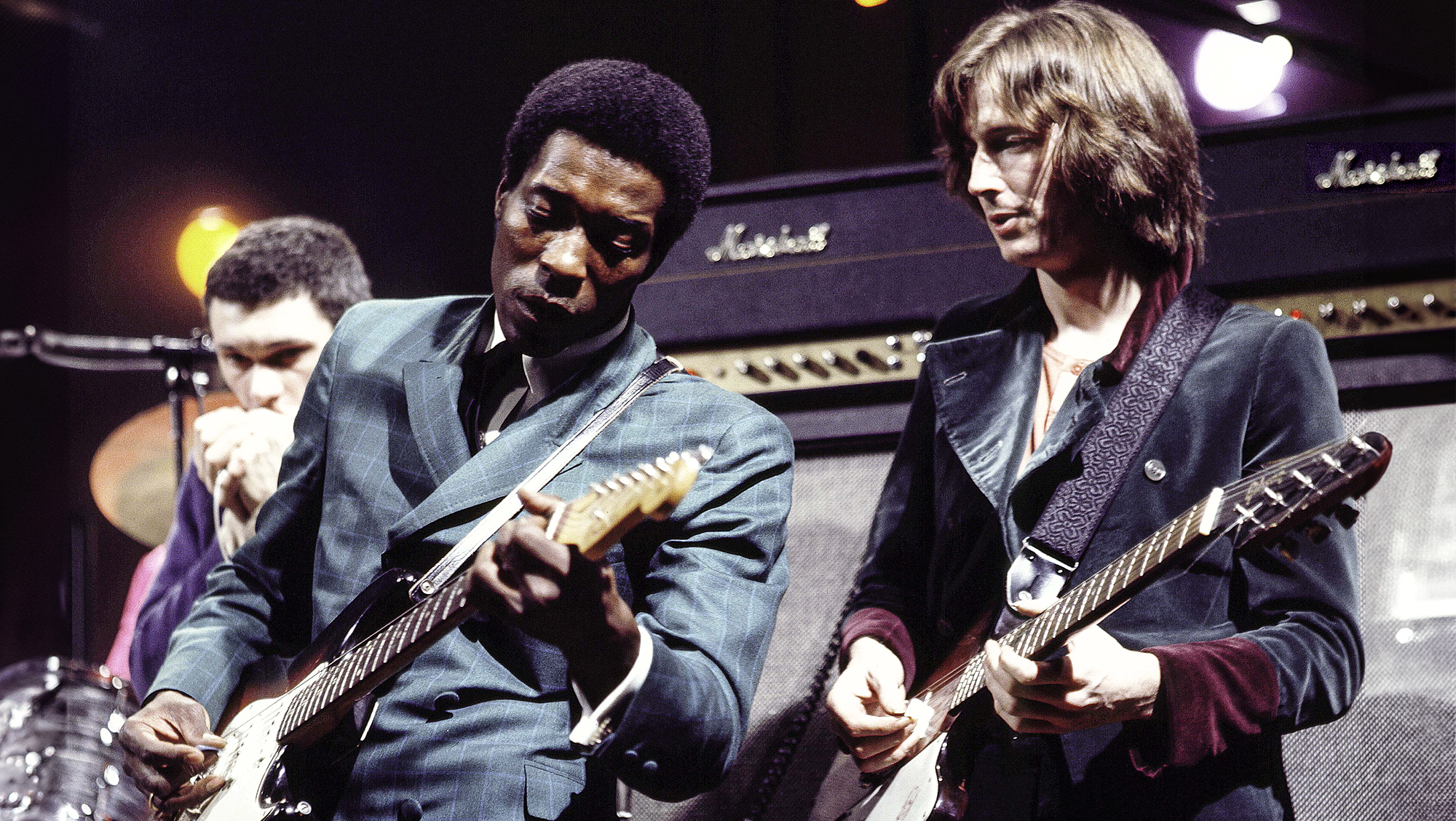Want to Add Intrigue to Your Playing? Try These Creative Ways to Harness the Ear-Catching Sounds of Suspended Chords
Give your improvising and composing a sharper edge

If you’re an aspiring guitarist eager to develop your playing on all fronts, it’s vital that you dedicate time to close-voiced triads.
These three-note stalwarts, the notes of which are confined to less than one octave, are the key to endless possibilities for not only rhythm playing but also soloing and compositional ideas.
It’s not uncommon for major and minor triads to get the lion’s share of attention while other chords, including diminished and augmented, receive less. But to paraphrase Mick Goodrick, one of the most prolific purveyors of triads on the guitar, all triads are of equal importance and should receive equal attention, so as not to limit one’s musicality.
In the spirit of Mick’s credo, I’m going to take you through two groups of related close-voiced triads that traditionally go under most players’ radars: suspended and altered suspended.
The open, airy and “suspenseful” sounds of suspended chords can serve as great embellishment or substitution elements in many different applications
While the suspended chord concept also applies to tetrads (four-note chord formulas, such as major, minor and dominant 7th chords) and further extended chords (such as 9ths, 11ths and 13ths), this discussion will focus on three-part harmony.
The open, airy and “suspenseful” sounds of suspended chords can serve as great embellishment or substitution elements in many different applications.
Some notable guitar luminaries who have composed long-lasting riffs with suspended chords include Jimmy Page, Alex Lifeson, Dave Matthews, John Mayer and Tom Petty.
All the latest guitar news, interviews, lessons, reviews, deals and more, direct to your inbox!
Altered suspended triads are more commonly heard in fusion, prog-rock and metal, and have been used by six-string innovators like Joe Satriani, Wayne Krantz and Fredrik Thordendal.
Their sound is less harmonically pleasing and can be challenging to the uninitiated ear. Give them a chance, however, as altered suspended chords will prove to be invigorating harmonic devices.
The term suspended, commonly abbreviated as “sus”, refers to the replacement of either the major or minor 3rd by the 2nd or 4th scale degree.
This creates the two types of suspended triads: sus2 (intervallically spelled 1 - 2 - 5) and sus4 (1 - 4 - 5).
Fig. 1 illustrates some standard sus2 and sus4 voicings, for which the 2nd or 4th is displaced up an octave, above the root and 5th, either of which is sometimes octave doubled. Sus2 and sus4 chords serve valuable functions in harmonic movements and chord progressions.
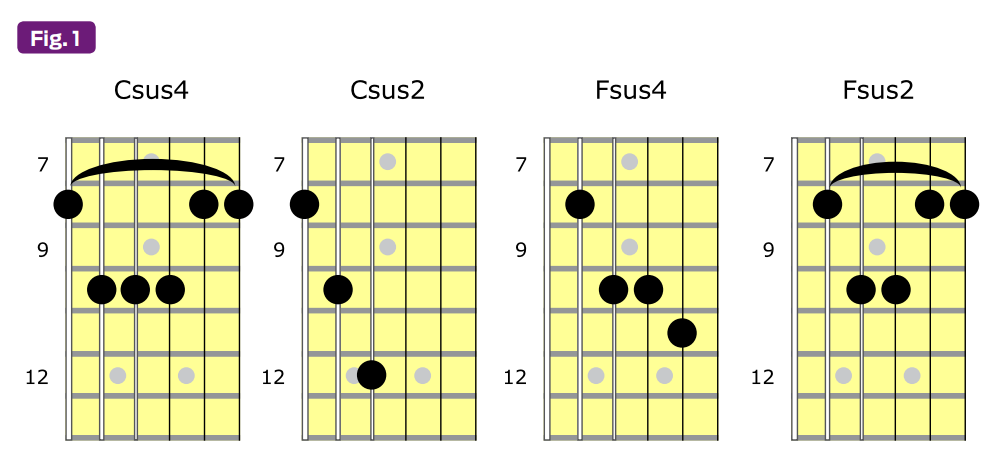
For instance, Ex. 1a is a simple I - V - I (1 - 5 - 1) cadence in the key of F (F - C - F), with the V chord (C) played on beat three.
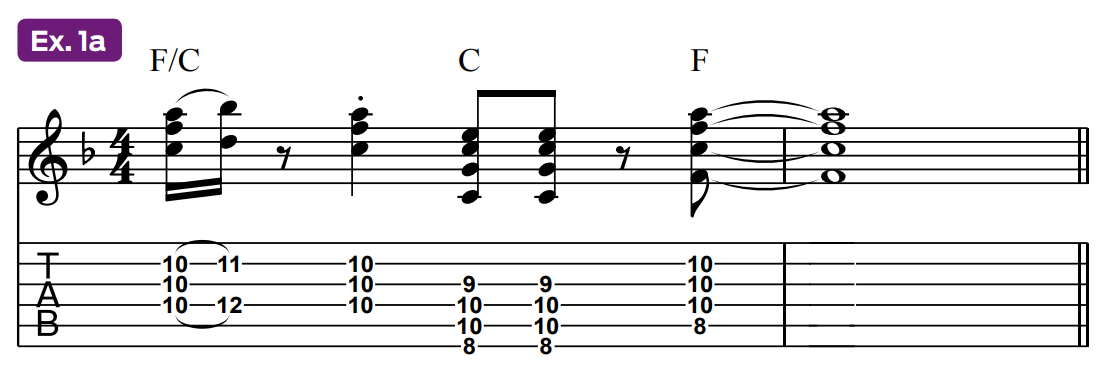
Ex. 1b is a slightly embellished variation of the phrase that places a Csus4 chord (spelled C, F, G) on the downbeat of beat three to create more movement leading into the final C–F resolution.
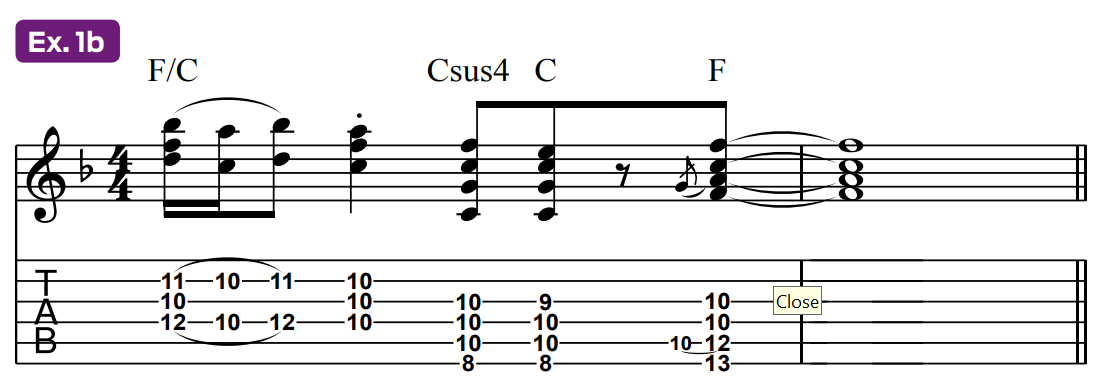
Since they are neither major nor minor, sus2 and sus4 chords can be used as variations on, or “extensions” to, both major and minor chords, with the 2nd or 4th taking the place of the major or minor 3rd.
In Ex. 2a, we have a i - bIII - iv progression in the key of C minor (Cm - Eb - Fm), played in a funky rhythm.
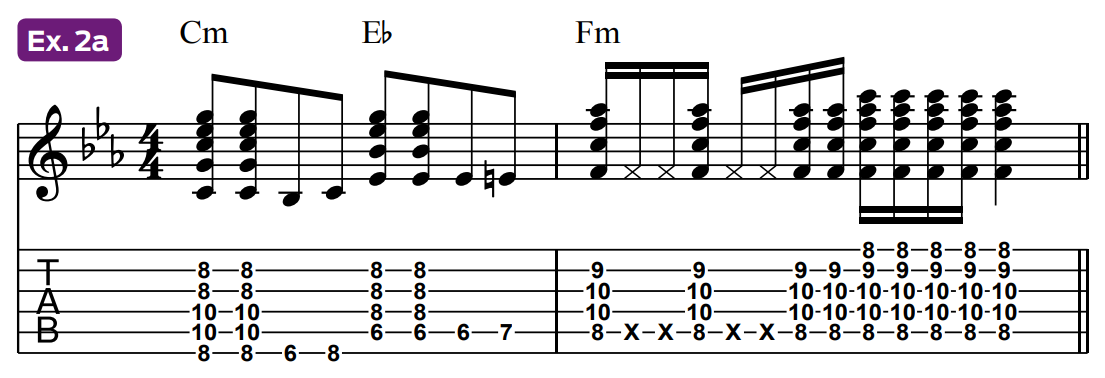
Ex. 2b offers an enhanced version of the same basic phrase that adds color and harmonic and melodic interest to bar 2 via an Fsus2 chord, which is used as an embellishment of Fm on beat three.
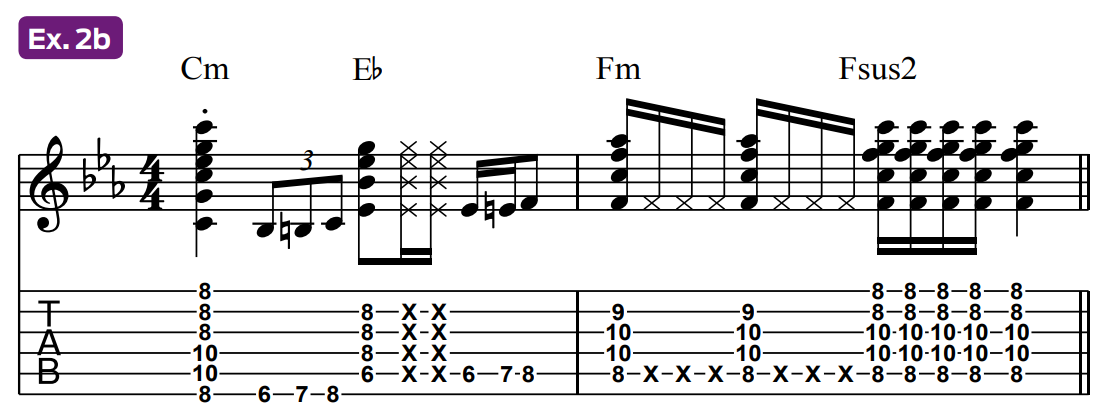
The suspended chords in Ex. 1b and 2b are voiced with certain chord tones moved up an octave and/or doubled, as described earlier and illustrated in Fig. 1.
You can also consolidate these suspended chords into three-note “close-voiced” (also known as “closed-voice”) triad sets, as shown in Fig. 2.

Close voicings contain all the chord tones within one octave. As a result, there is only one of each chord tone in a voicing (no octave doubling), and they are clustered as closely together as possible.
Ex. 3 applies this more economical voicing approach to a I - V - I cadence in the key of C (C - G - C), with all three close voicings of Gsus4 (spelled G, C, D) from Fig. 2 employed in place of a G major triad (G B D).
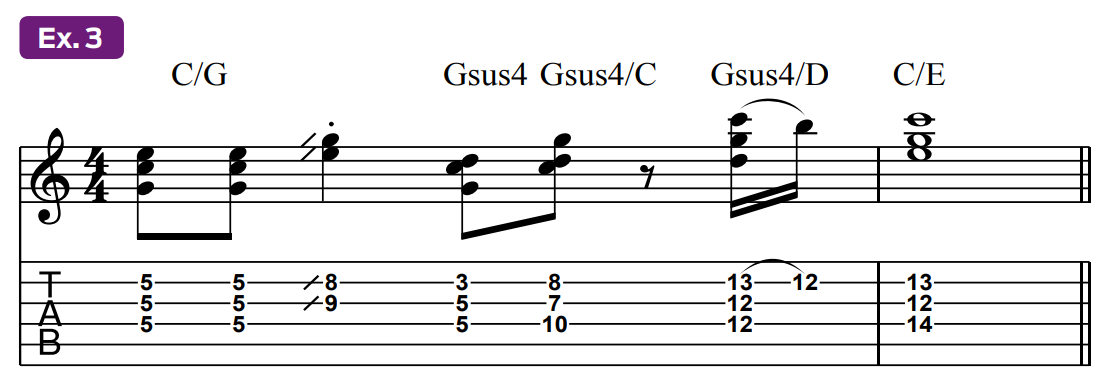
Ex. 4 is based on a i - bVImaj7 - iv - V progression in the key of G minor (Gm - Ebmaj7 - Cm - D) and utilizes the close voicings of Csus2 (C, D, G) from Fig. 2, starting on beat two of bar 2.
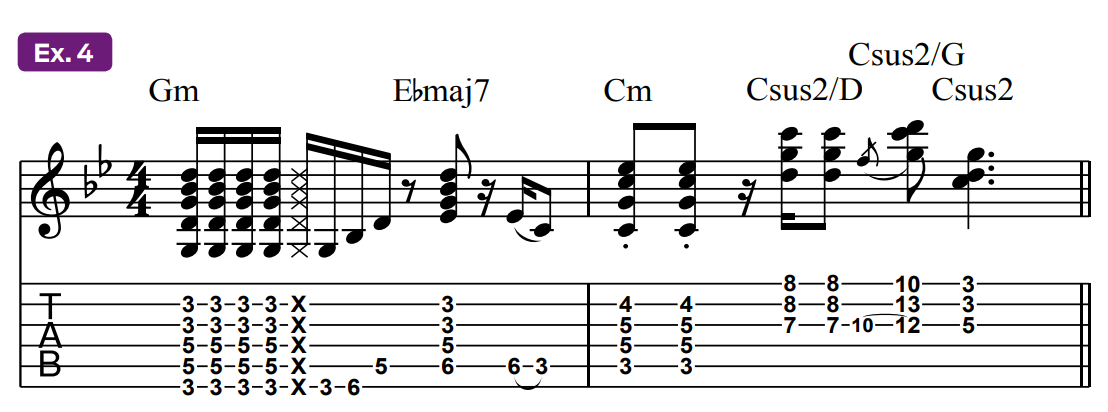
Take note of the legato embellishments (hammer-ons/pull-offs) in both examples.
Sus4 and sus2 chord structures create convenient fingerings on all string sets that set up good opportunities for these kinds of legato embellishments.
This is a key concept and device to employ for the sake of upping your rhythm playing while ensuring that you stay “in the pocket.”
To this point, the sus4 and sus2 triads presented thus far have been played horizontally, or laterally, up and down the fretboard on the string sets 4-3-2 and 3-2-1.
In Fig. 3 you can see how they work vertically, moving across the neck on all trios of adjacent strings.

With each successive voicing (moving left to right across the page), the lowest chord tone from the previous shape jumps up an octave.
Notice how both rows start and end with the same root-position 1 - 4 - 5 or 1 - 2 - 5 voicing, played an octave higher.
Strive to commit these chord shapes to visual, aural and muscle memory.
Ex. 5 puts the C-rooted suspended triads to work with a two-bar “ricochet” run played across the strings.

Try hybrid picking the first two beats of each bar and switching to strumming with the pick on beat three to play the four consecutive 16th notes.
Coming from a parallel approach, Ex. 6 explores vertical sus4 triad sets based off a common 8th-fret C note on the low E string, which first served as the root of the Csus4 voicings in Ex. 5.

Here, in the first two bars of Ex. 6, it’s the perfect fourth in a series of Gsus4 (G, C, D) vertical voicings, and in bars 3 and 4 the fifth in a series of Fsus4 (F, Bb, C) voicings.
Playing off a common parallel bass note like this is a great way to see inversions as their own devices rather than connected to a relative system.
Working with suspended triads as three-note close voicings, you’ll notice a symbiotic connection between sus4 and sus2 shapes when you start exploring inversions.
Due to the “openness” of suspended chords – with a perfect 4th interval between the root and 4th or the 2nd and 5th – whenever you play a close-voiced sus4 triad, you’re also hearing the texture of a sus2.
In the table below, you can begin to see why. Check out the Csus4 in root position along with its first and second inversions in the left column and notice how each chord has a sus2 counterpart, or what I call a mirror chord, in the right column.
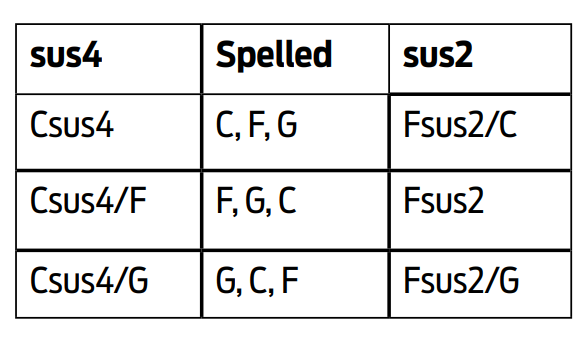
The most precise method of naming mirror chords is to set aside slash-chord naming conventions and identify the chords in their actual form, which is based off their lowest note.
Looking at the middle column, Csus4 (C, F, G) and Fsus2 (F, G, C) would be named as such, while the voicing on the bottom, spelled G, C, F would be a G7sus4, minus the 5th, D. Note: 7sus4 is a four-note tetrad chord formula. It is the absence of the 5th (D, in this case), which has no bearing on the G7sus4 chord quality and naming, that makes this chord part of the grouping of three-note-voiced triads.
In the end, whichever naming convention you choose to identify suspended chords and their inversions should be based on what makes most sense to your applications.
As with any harmonic concept, you can bolster your understanding through harmonized scales, or more simply named, chord scales.
It’s always a good idea to start with a linear, static chord scale.
Made up of a single voicing type, each chord tone progresses in a consistent step-wise motion.
With that said, Ex. 7 takes that idea and combines sus4 and sus2 into a single ascending chord scale in the key of F major (F major scale: F, G, A, Bb, C, D, E).
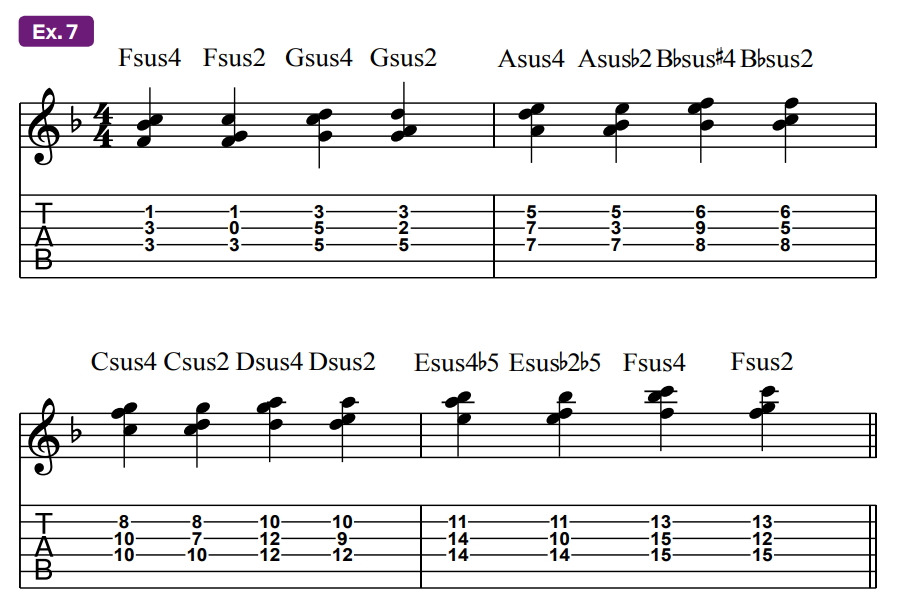
First- and second-inversion chord scales can follow suit, but with voice-led cycles you can play through all three inversion types in one long chord flow, as demonstrated in Ex. 8.
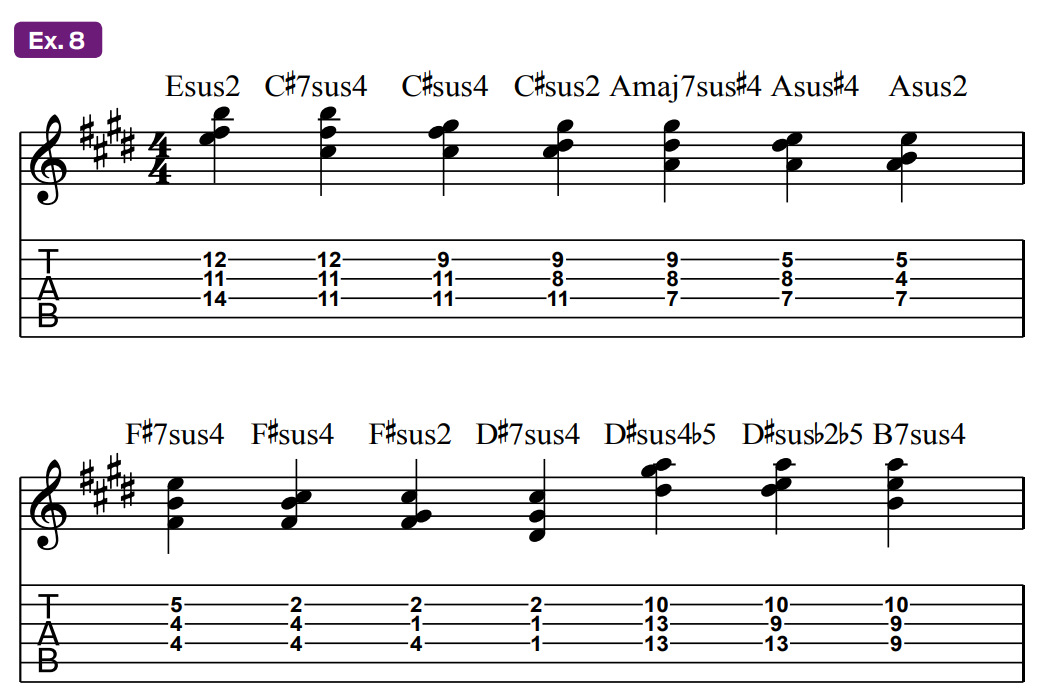
Here we have a descending E major suspended chord scale in a cycle of thirds (E major scale: E, F#, G#, A, B, C#, D#).
As you play through this three-bar sequence, watch for the octave shift between beats four and five in bar 2.
Also, with respect to the suspended mirror-chord idea, notice that the naming convention follows an actual-form approach rather than a slash-chord naming approach.
A repeating pattern of 7sus4 - sus4 - sus2 chord types with common roots can be seen after the initial Esus2.
It’s always a good idea to make use of any mental connective devices that can help you internalize a concept such as this. As a result, you’ll think less and play more.
An examination of diatonic suspended chord scales leads us to altered suspended triad harmony.
Diatonic harmony contains four possible altered suspended voicings: susb2 and susb2b5, sus4b5 and sus#4. Among these, sus4b5 mirrors susb2, while sus#4 mirrors susb2b5.
Once again, both mirrored pairs include a fifth-less major-7th voicing in their inversion set: Just as the 7sus4 chord in unaltered suspended harmony coexists with sus4 and sus2 in an inversion set, sus4b5 and susb2 are joined by maj7sus#4, whereas sus#4 and susb2b5 include maj7sus4 to form their own sets.
Throughout Ex. 8, you played each of these types and the fingerings they produce on the 4-3-2 string set.
Consistent with focusing on the two highest adjacent-string trios, Fig. 4 maps out the fingerings on the 3-2-1 string set while displaying the actual chord names derived from their respective bass notes.

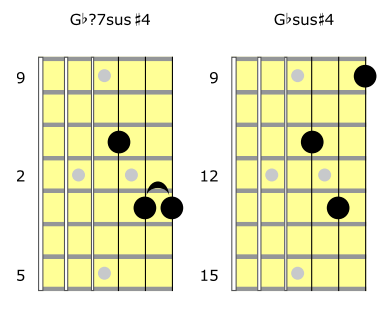
Names and fingerings notwithstanding, altered sus chords produce stimulating sounds that should certainly snap listeners to attention.
The next two examples show off how these piquant sounds can be effective tools for conveying modal sounds.
For example, Ex. 9 puts forth a D Dorian feel (D Dorian mode: D, E, F, G, A, B, C), propelled by the Bsusb2b5, Fmaj7sus#4 and Fsus#4 chords in bar 1.
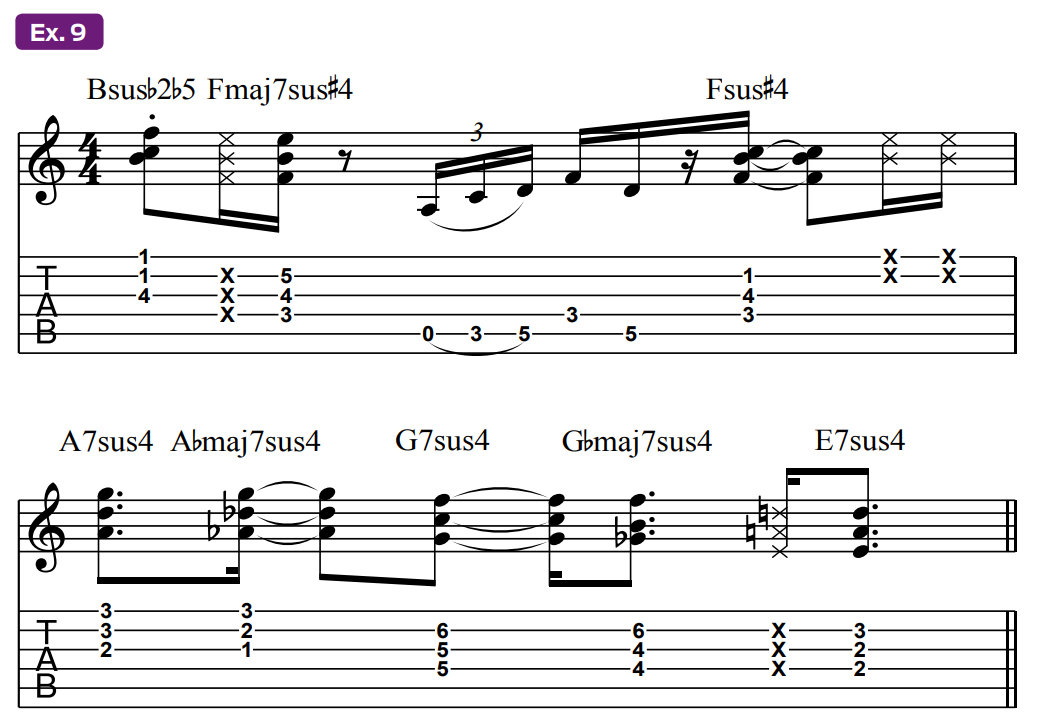
Examining the tones of each chord reveals the connection to the scale. For instance, Bsusb2b5 is spelled B, C, F. This is the 6th, b7th and b3rd of D Dorian, which are signature Dorian tones. Fmaj7sus#4 and Fsus#4 also feature an F and a B, which make up the defining minor-3rd/ major-6th tritone in Dorian.
Shifting to the A Dorian mode (A, B, C, D, E, F#, G), Ex. 10 makes use of an F#sus4b5 (F#, B, C) triad in two different octave ranges throughout bar 1, in the same manner as the previous example, with respect to the signature Dorian tritone (in this case, F# and C).
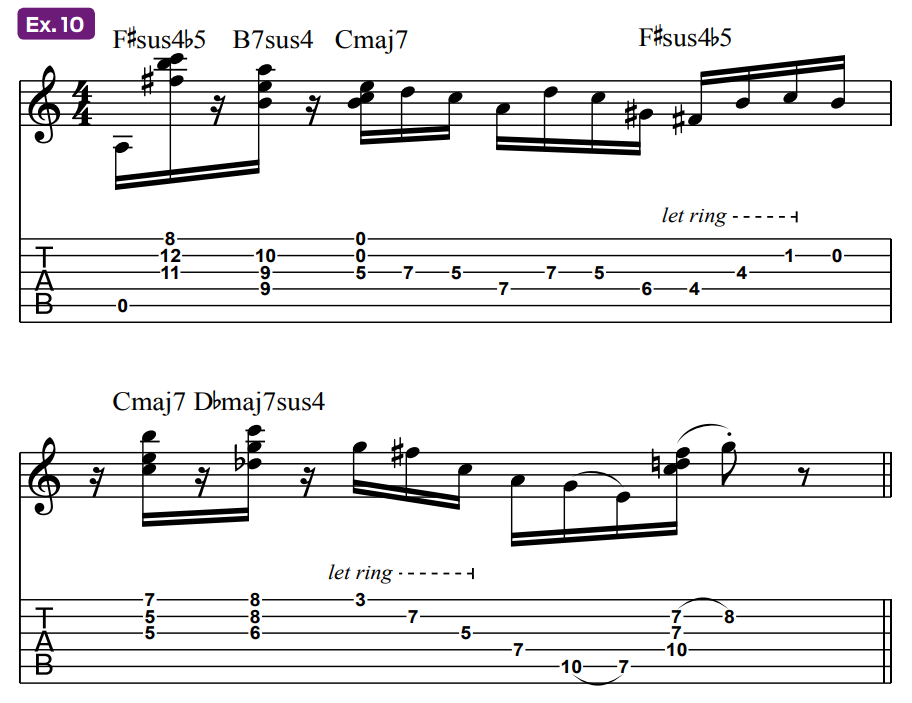
Together, diatonic and altered suspended triads can add fresh and fascinating sounds to your playing and writing.
Take time to acquaint yourself with these new shapes and sounds and to decide how best to interpret and use them.
Once you have a good grasp of suspended chords, you will find that your playing, improvising and composing will have a sharper edge.
Chris Buono is a top-selling TrueFire Artist with nearly 50 instructional videos, and a featured instructor on guitarinstructor.com. Bookending his years as a Berklee professor, he authored eight books, including the popular Guitarist’s Guide to Music Reading and his most recent publication, How to Play Outside Guitar Licks.

